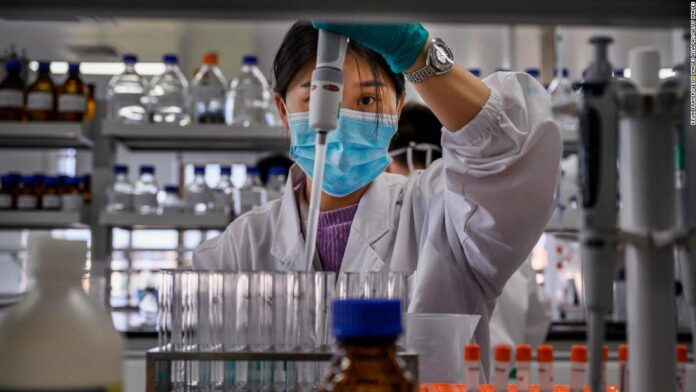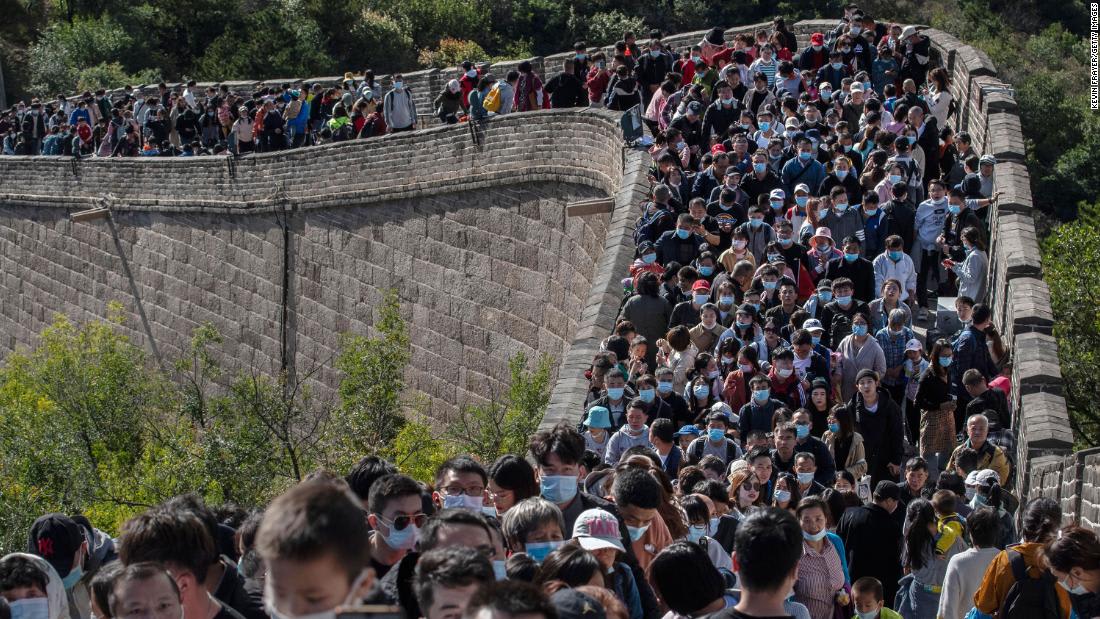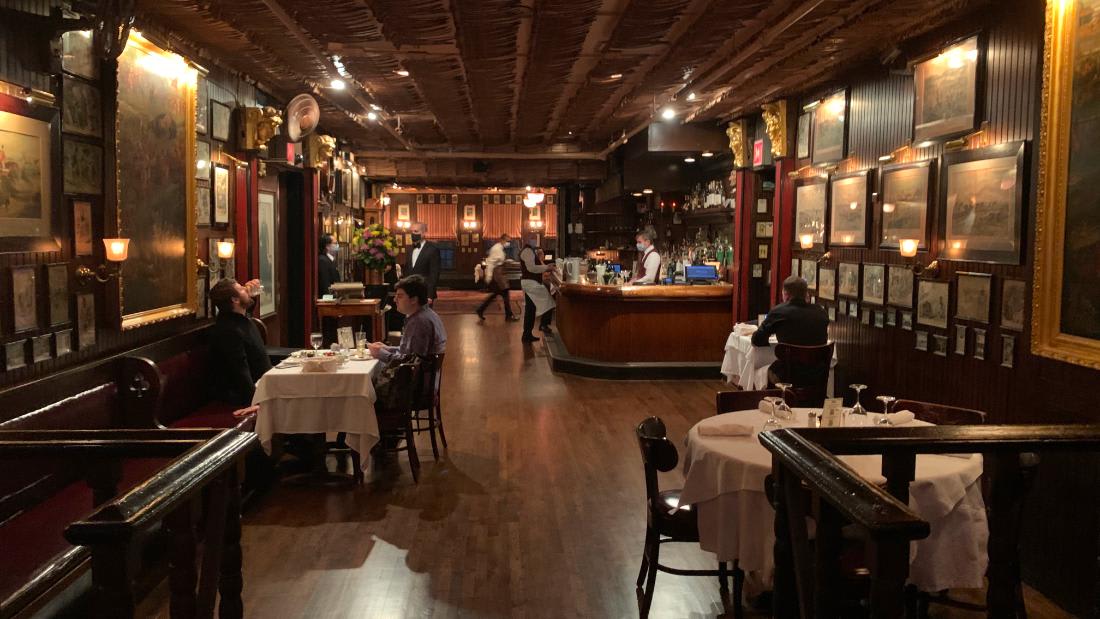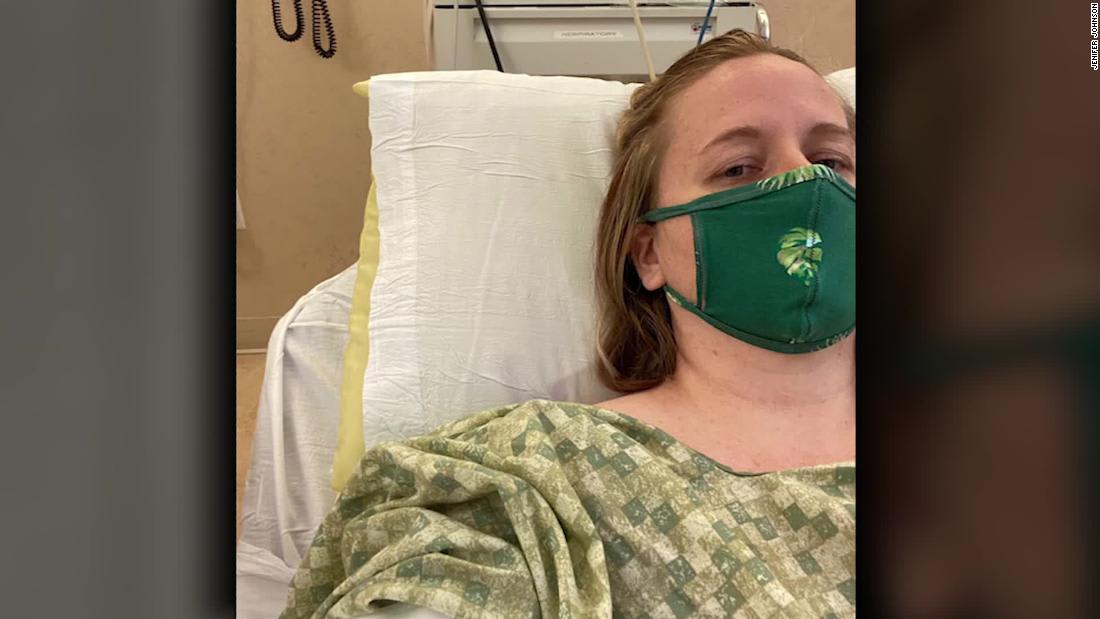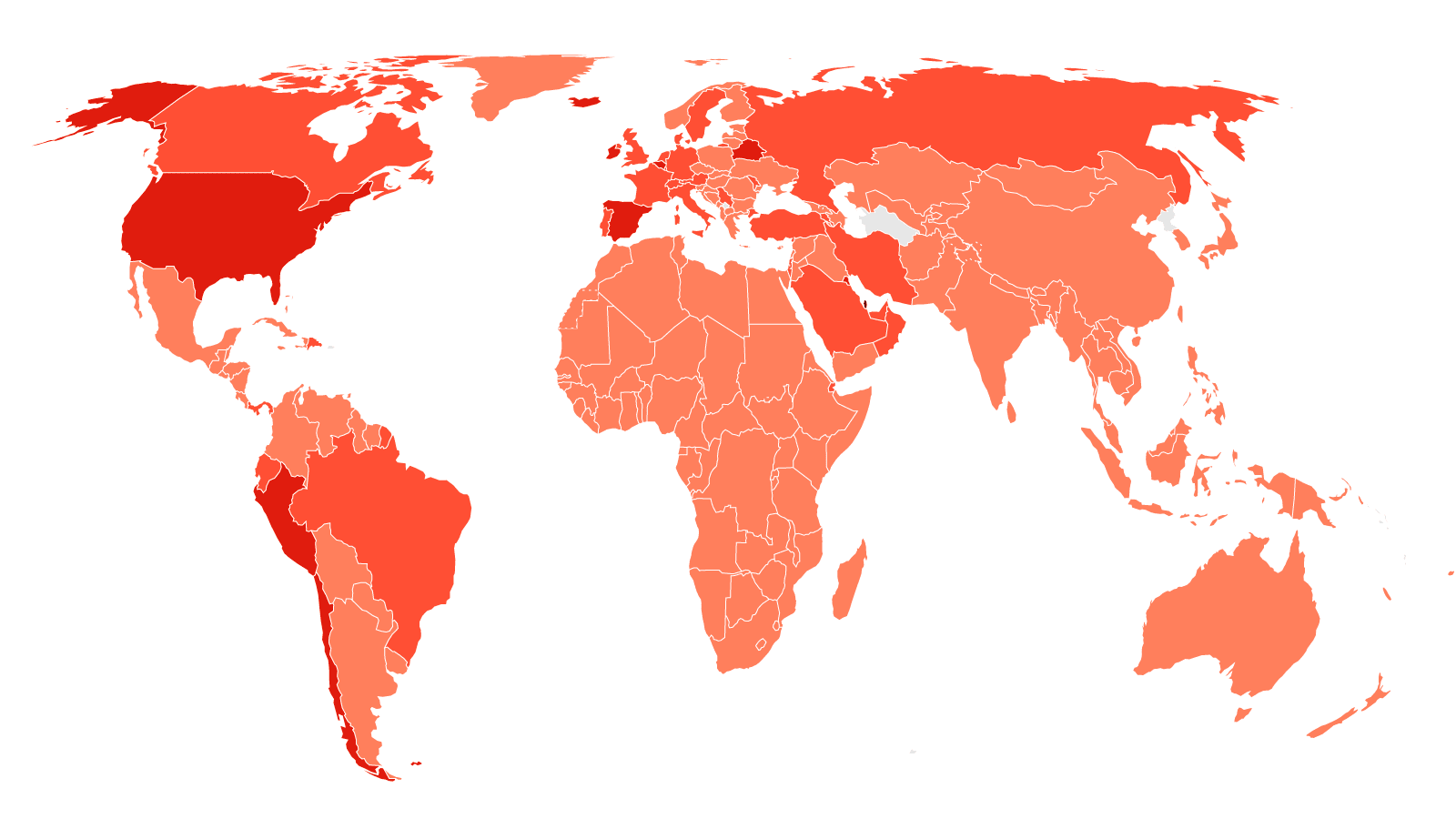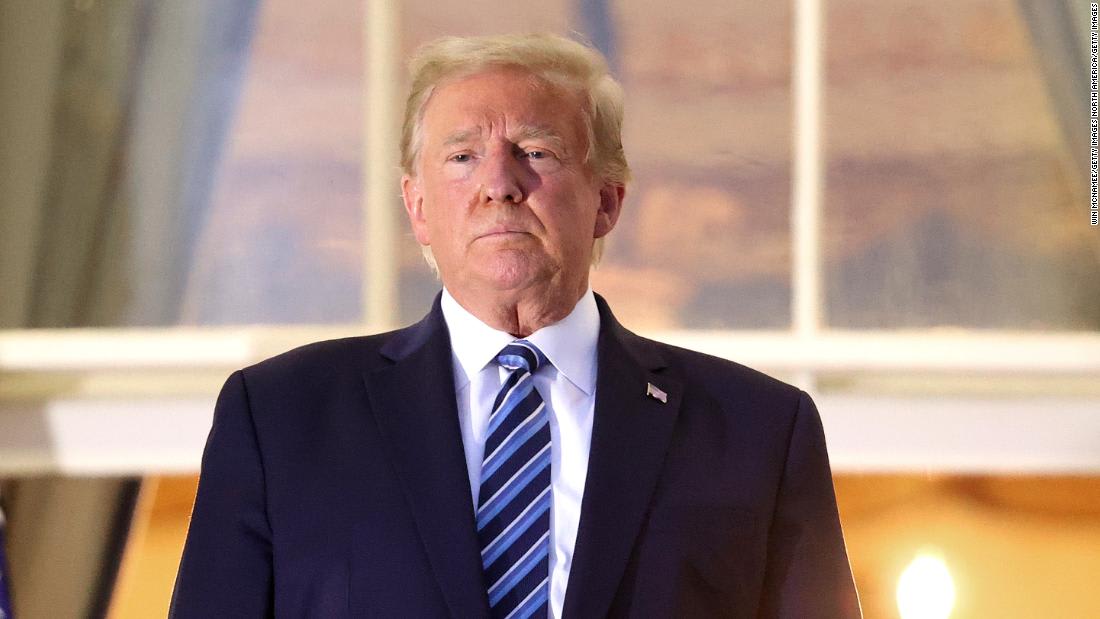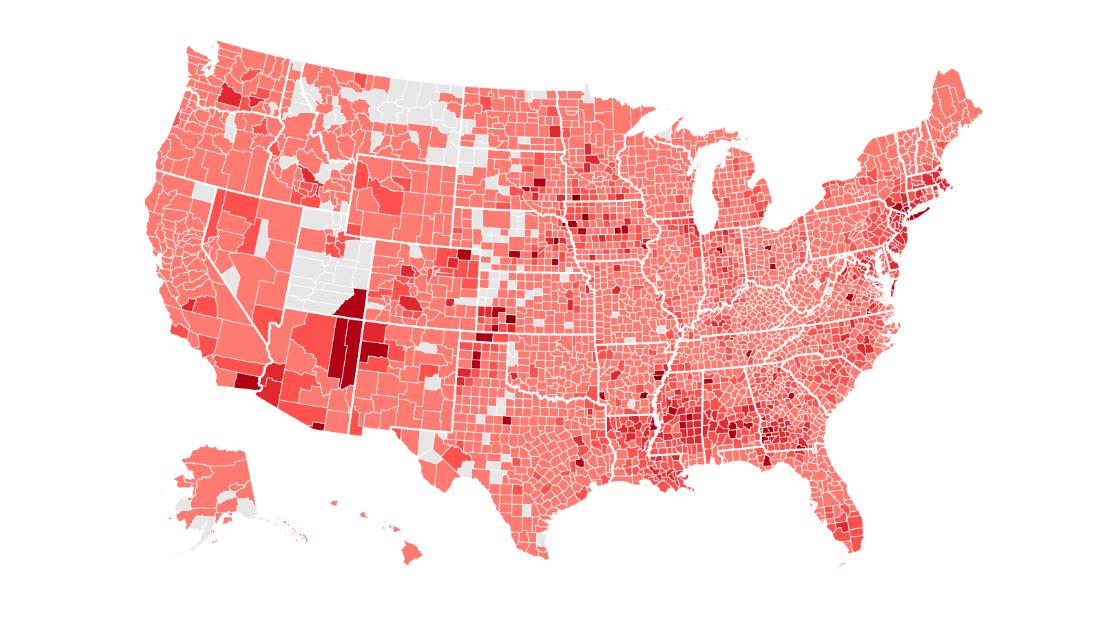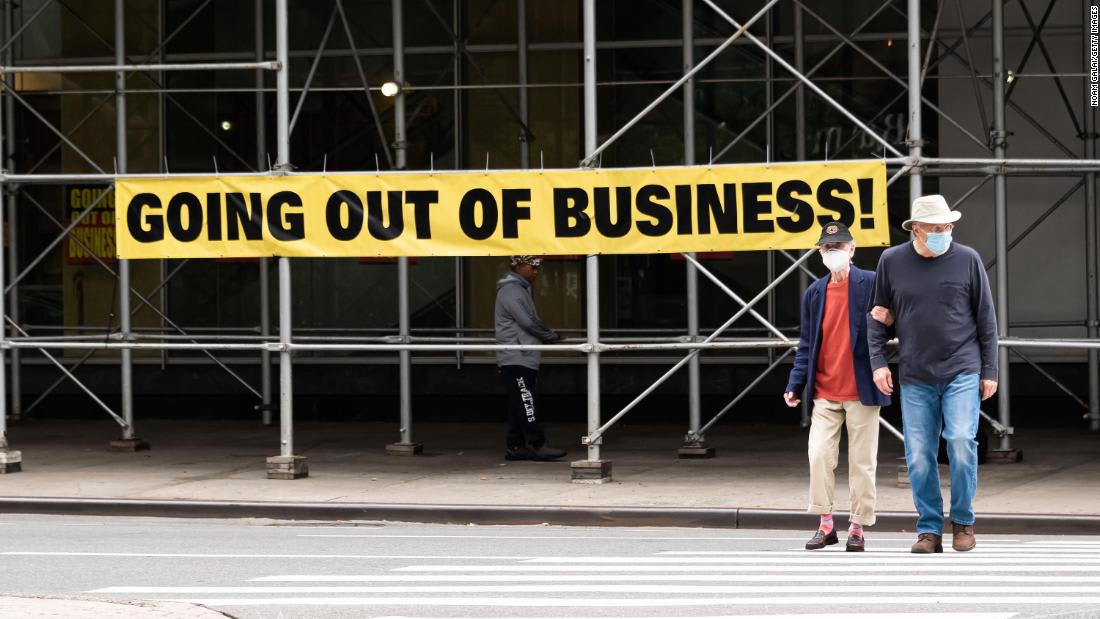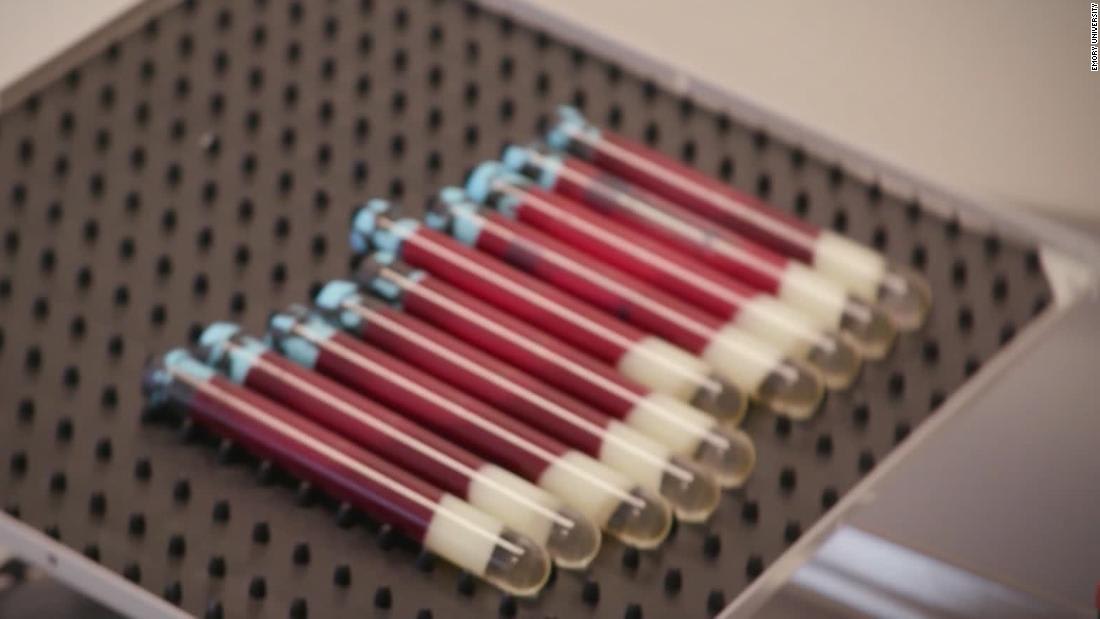What pandemic? Crowds swarm the Great Wall of China as travel surges during holiday week
From CNN’s Jessie Yeung
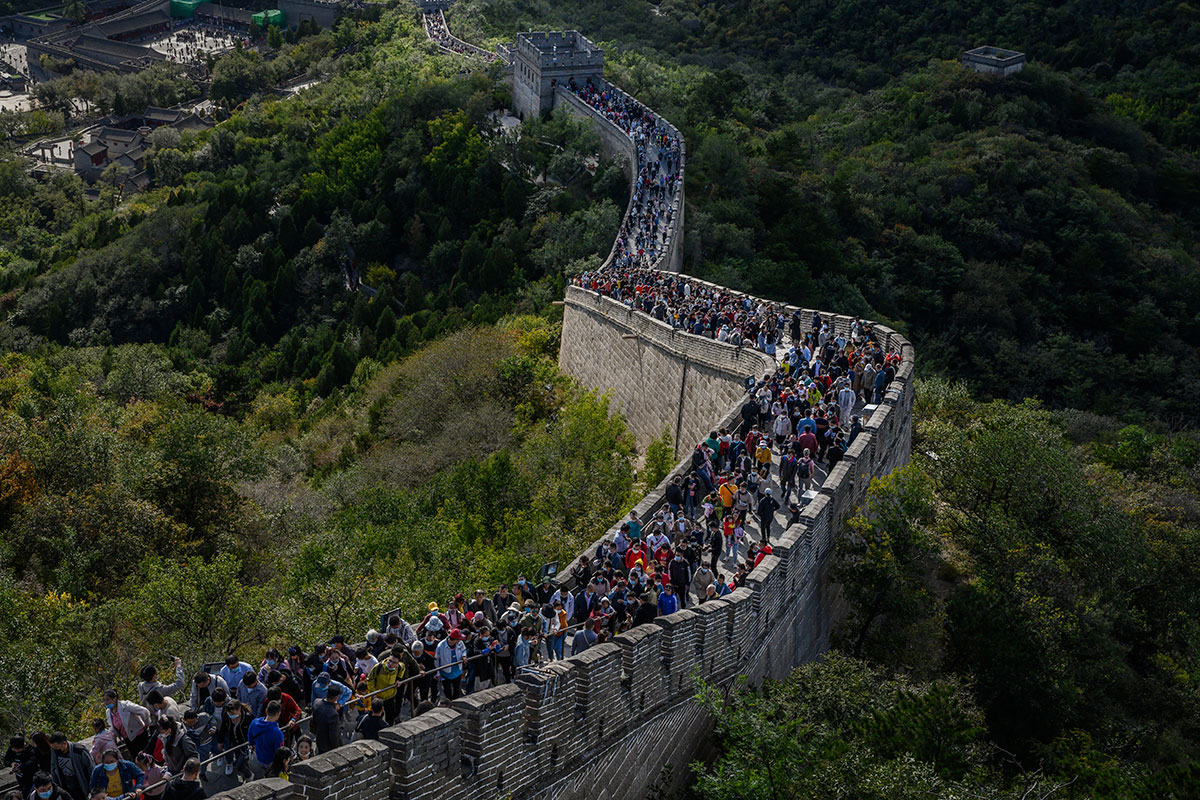
The scene at the Great Wall of China this past week would have been unthinkable just months ago.
Photos of the tourist attraction in Beijing last weekend show massive crowds crammed along the winding wall, pressed together in close quarters and squeezing past each other through narrow doorways. Most are wearing face masks — but a number of people, including young children, pulled their masks down to their chin, and a few seem to have foregone masks entirely.
It’s Golden Week — an eight-day national holiday, one of China’s busiest annual travel periods, and a major test for the country as it emerges from the coronavirus pandemic.
China‘s official reported virus numbers have stayed low since the spring. There have been a few flare-ups, including a cluster in Beijing in June, but these were met with immediate lockdown measures and mass testing, and the outbreaks were contained within a few weeks.
With close to zero local transmissions, people flocked to bus stations, airports and transit hubs to travel around the country for the holiday, which kicked off on October 1. Local authorities competed to attract tourists, with provincial and municipal governments issuing travel vouchers and tourist attractions offering free or discounted tickets.
The Great Wall has geared up for the rush of tourists as well. The most popular section of the wall — the Badaling section — reopened at the end of March, albeit with new restrictions like requiring visitors to reserve tickets in advance.
Read the full story and see more photos here:
My first indoor dinner since Covid-19 hit
From CNN’s Brekke Fletcher
Remember sitting down at a restaurant and unwrapping silver utensils folded elegantly in a white cloth napkin? Yeah, me neither.
Since March 22 when the stay-at-home order all but shut down New York City and state — following similar orders in Washington state and California — restaurants and bars were shut down and later open only for takeout or delivery.
New York City without restaurants is — or was — unfathomable. When I moved here from California, the main reason outside of career ambitions was the food.
The best restaurants in the country are here, the best chefs, the most international cuisines.
I would eat like a queen at Pasha, an old favorite Turkish restaurant on the Upper West Side of Manhattan. I would hop on the F train from Brooklyn through Manhattan to Queens for delicious Indian curries at Jackson Diner.
I’d head up to Arthur Avenue in the Bronx and shop at Italian markets and stuff myself on cannoli from Marrone and celebrate at bacchanalian Italian feasts at Puglia, an century-old establishment in Little Italy where resident crooner, Jorge Buccio, would lead cheerful diners in “The Napkin Song.”
Then there’s all the fine dining: Le Bernardin remains my No. 1 favorite New York City restaurant and securing reservations there for myself, friends and colleagues brought such a sense of victory, I can barely describe it. Think of it as winning a gold medal, but you know, with an email confirmation from Resy.
So here we are, one week after restaurants in New York City reopened at 25% capacity. I’ve been eating outdoors since July — not often — but enough to keep my restaurant-related madness in check. But now it was time to go back to some semblance of reality.
Read the full story:
What we know about what it’s like to recover from Covid-19 and its long-term effects
From CNN’s Steve Almasy
More than 35 million people around the world have tested positive for the novel coronavirus that causes Covid-19, according to data compiled by Johns Hopkins University.
And even if that figure is an enormous undercount of the people who have had the disease — as the World Health Organization and other experts say it is — it means tens of millions of people have had the disease and then been able to leave isolation.
Some people are back to normal health within weeks. But for others, issues persist for months or cause damage that might lead to other health issues in the future.
Here’s what we know now about recovering from Covid-19:
- It varies by person
- It depends on your underlying health issues
- Some symptoms might linger
- The virus might lead to other damage
- There can be some long-term issues
- Many who are hospitalized could become long haulers, a study suggests
- Just because you weren’t hospitalized doesn’t mean you won’t have long-term problems
- We’re still learning about the recovery process
Read the full story:
Germany reports highest number of new coronavirus infections since April
From CNN’s Nadine Schmidt in Berlin
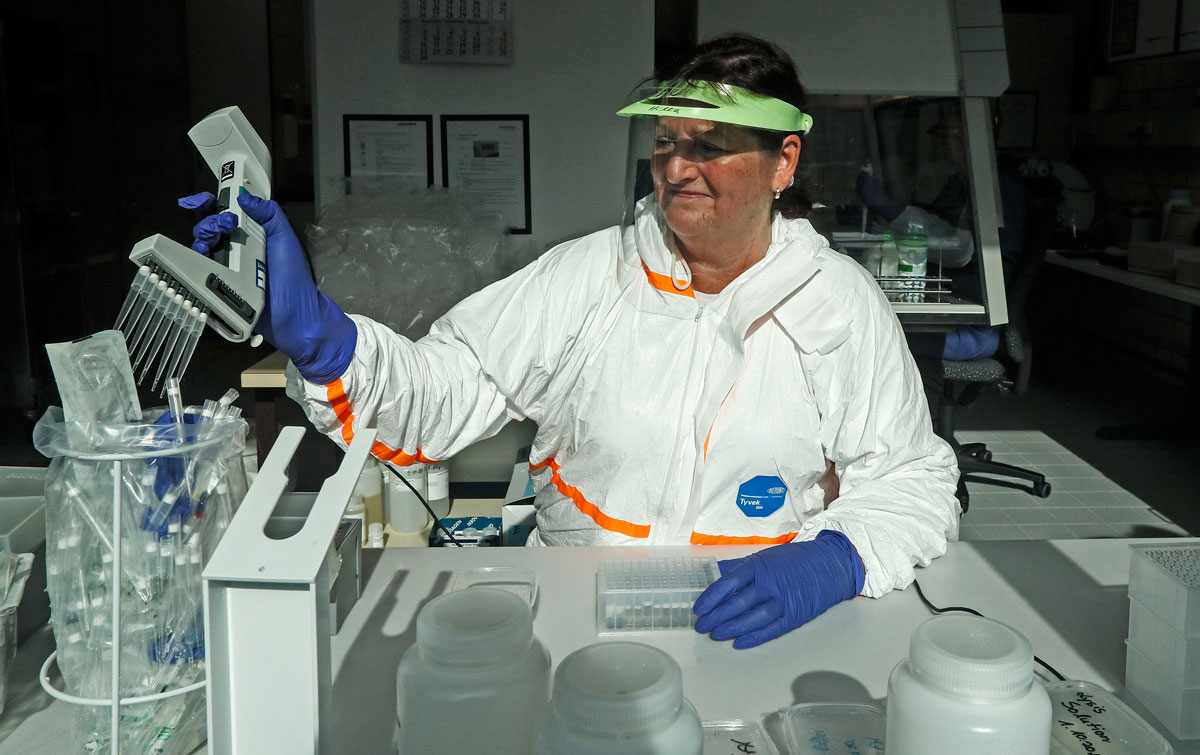
Germany reported 2,828 new Covid-19 cases on Wednesday — the highest number of daily infections since April 18, according to the country’s center for disease control, the Robert Koch institute.
The country has now recorded more than 306,000 coronavirus cases, including at least 9,562 deaths.
Germany’s infections peaked between the end of March and start of April, when authorities recorded more than 6,000 cases a day.
The confirmed daily cases fell significantly, although reported infections have been rising again in the country since the end of July.
CNN is tracking worldwide Covid-19 cases:
Analysis: Trump’s erratic behavior ignores worsening pandemic and its victims
Analysis from CNN’s Stephen Collinson
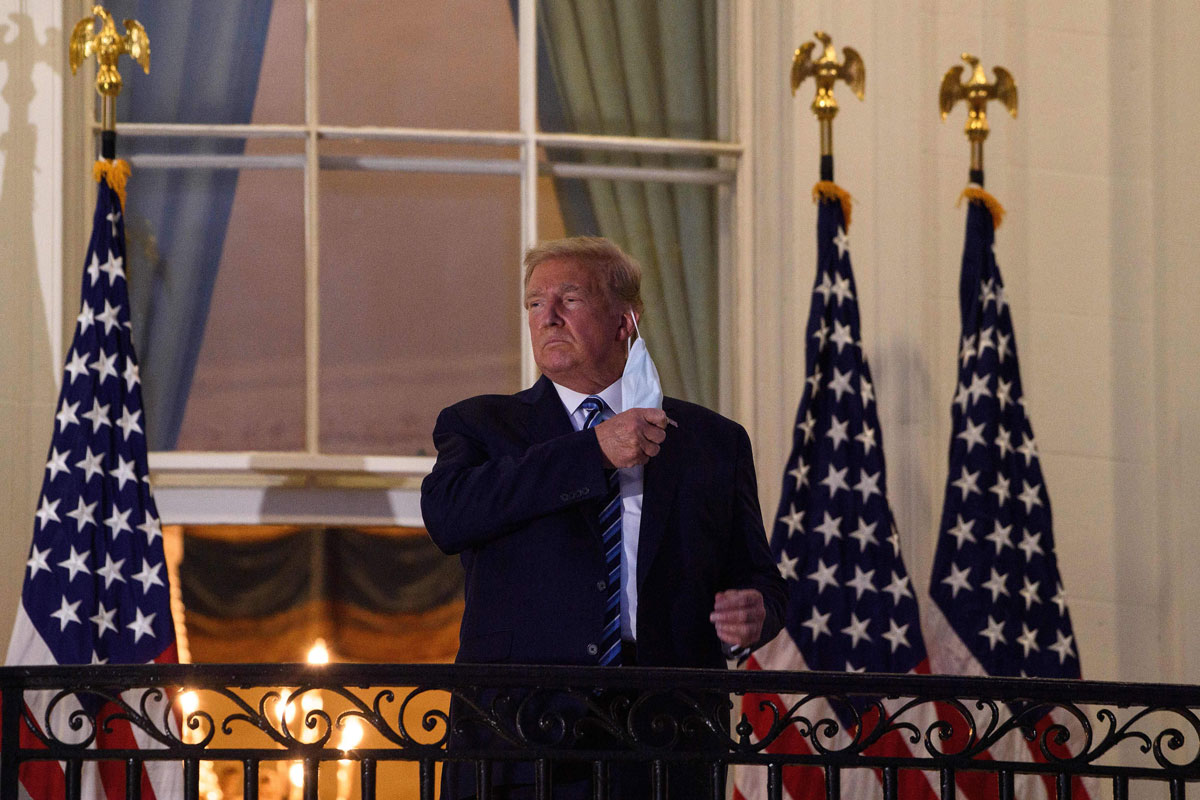
A defiant President Donald Trump is chasing his own political goals while ignoring the human and economic toll of the pandemic, with his super spreader White House in chaos and top Pentagon generals in quarantine.
With uncertainty still clouding official bulletins of the President’s condition as he battles Covid-19, there is increasing bewilderment in Washington at some of his tone deaf and erratic moves since leaving the hospital on Monday.
Trump suddenly blew up congressional negotiations on a Covid-19 economic rescue package. And in a fresh assault on public health strategies needed to quell a now-accelerating pandemic, Trump claimed falsely that it was no worse than the flu, as he portrays himself as a hero leader who conquered the virus.
By reinforcing his denial of a national emergency that has killed more than 210,000 Americans, Trump is adopting a high-risk strategy that potentially offends bereaved relatives of those who died from the disease and almost everyone else who has seen their lives, schooling and family life shattered. By squelching economic rescue talks, he leaves himself open to charges of indifference to the plight of millions of Americans thrown out of work during the pandemic and who relied on now expired federal unemployment benefits.
Democratic nominee Joe Biden seized on the sense that the Trump White House is running off the rails to pledge to restore national unity and to lead the nation out of the pandemic, following in Abraham Lincoln’s footsteps in warning America was again a “house divided” on the battlefield at Gettysburg, the scene of the Civil War’s bloodiest clash.
Trump’s latest attempts to downplay the virus — even as he is on a regimen of strong and experimental drugs to fight his own infection — are sure to be a centerpiece of Wednesday night’s debate between Vice President Mike Pence and the Democratic vice presidential nominee, Sen. Kamala Harris of California.
Read the full analysis:
US surpasses 7.5 million coronavirus cases

The United States recorded at least 43,562 new coronavirus infections and 705 virus-related deaths on Tuesday, according to Johns Hopkins University.
The nationwide totals now stand at 7,500,964 cases, including at least 210,886 deaths, per JHU’s tally.
The totals include cases from all 50 states, the District of Columbia and other US territories, as well as repatriated cases.
CNN is tracking the US cases:
Man digs hole to escape coronavirus quarantine
From CNN’s Yoonjung Seo in Seoul
A man has escaped coronavirus quarantine in South Korea by digging a hole underneath a temporary wall at a government facility in Seoul, according to health authorities.
Health official Son Young-rae said Wednesday that the man, an Indonesian sailor, entered the country on a seafarers’ visa and began his quarantine on September 21.
He was due to be released on October 5, but dug his way out of the facility the day before.
According to Son, the man’s Covid-19 test result was negative when he entered the country and he didn’t show any symptoms of coronavirus.
Police are still searching for the man and analyzing CCTV footage. Since the incident, additional CCTV cameras have been installed at the quarantine facility and more police officers have been dispatched to the center, Son said.
Foreigners who arrive in South Korea must quarantine at a state facility for 14 days unless they are residents of the country.
The situation in South Korea: On Wednesday, authorities reported 114 new coronavirus infections nationwide, of which 94 cases were locally transmitted and 20 imported.
The total number of confirmed cases for the country stands at 24,353, including 425 deaths.
South Korea is experiencing a fresh wave of cases, prompting authorities to restrict gatherings.
Trump halted stimulus talks. Here’s what it means for you
From CNN’s Tami Luhby and Katie Lobosco
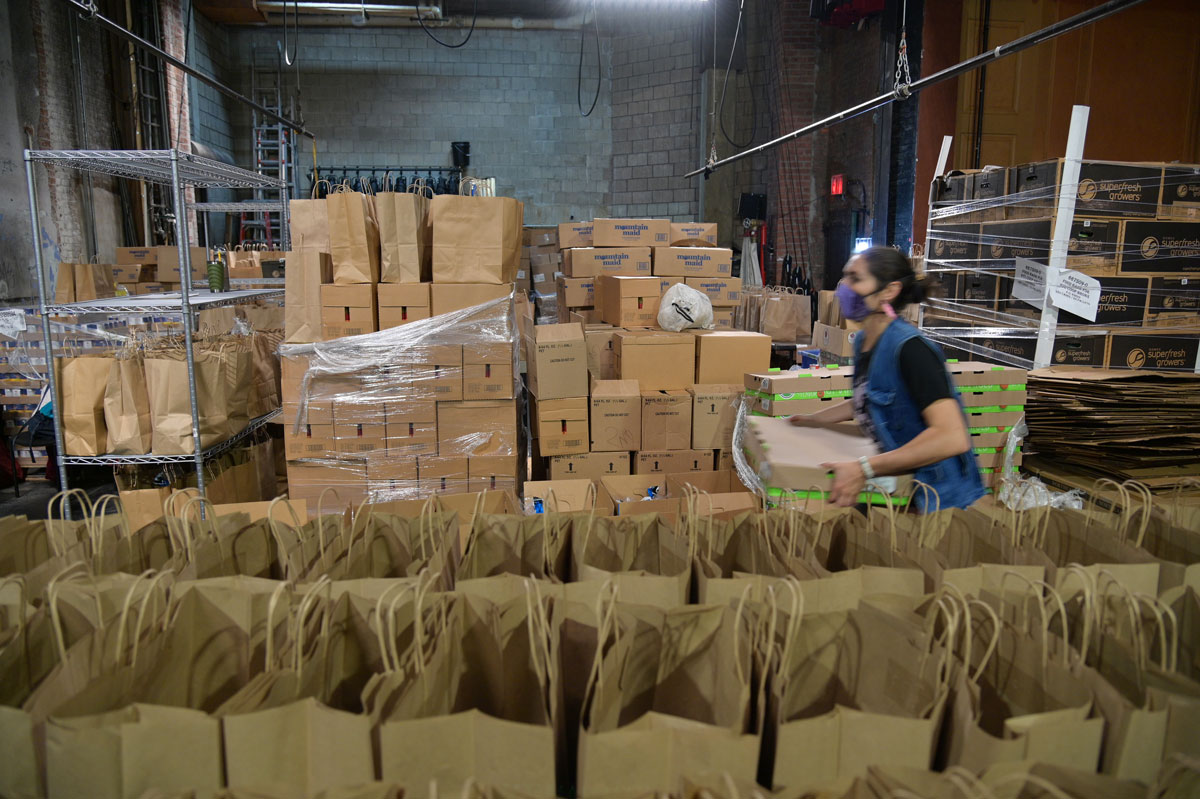
Millions of Americans are still out of work. Many small businesses and major airlines are struggling to stay afloat. And states are still contending with massive budget gaps.
But none of them — nor others in need of relief from the coronavirus pandemic — will receive assistance from the federal government anytime soon, now that President Donald Trump has ordered a halt to negotiations with the Democratic-led House of Representatives.
The two sides never got very close in their efforts to pass another major economic rescue package, though talks had been continuing. The House last week released a $2.2 trillion version of the $3 trillion relief bill it had passed in May, while the White House was looking at a package in the $1.5 trillion range.
Another round of federal stimulus funding was seen as vital to propping up the nation’s economy at a time when the recovery is weakening. Prior rescue packages provided much-needed money to stabilize Americans who lost their jobs and businesses that lost their customers amid the pandemic.
Just hours before Trump’s announcement, Federal Reserve Chairman Jerome Powell reiterated his calls for more fiscal stimulus, saying that “the risks of overdoing it seem, for now, to be smaller” than not providing more help.
“The expansion is still far from complete,” Powell said Tuesday at the National Association for Business Economics annual meeting. “Too little support would lead to a weak recovery, creating unnecessary hardships for households and businesses … Even if policy actions ultimately prove to be greater than needed, they will not go to waste.”
Here’s what was under consideration:
- A second round of stimulus checks for 160 million people
- Boost to unemployment benefits
- Money for small businesses
- Relief for state and local governments
- More education funding
- Support for Covid-19 testing, contact tracing, vaccine development
- Enhanced food stamp benefits
- Money for the Postal Service
- Liability protections
- Help for airlines
Read the full story:
FDA wants two months of safety data before considering Covid-19 vaccine
From CNN’s Jacqueline Howard and Maggie Fox
The US Food and Drug Administration made clear Tuesday it will want to see two months of follow-up data after volunteers get their second dose of vaccine as part of clinical trials testing potential coronavirus vaccines.
That would make it difficult, if not impossible, for any vaccine maker to apply for emergency use authorization by Election Day, as President Donald Trump has suggested, or by the end of October, as the CEO of Pfizer has hinted.
The process will also make it “pretty darn hard for mischief,” National Institutes of Health Director Dr. Francis Collins said.
The agency posted new guidance for manufacturers that says they need to provide at least two months of follow-up safety data after vaccinating volunteers before even asking the FDA to consider giving emergency use authorization (EUA) for a vaccine.
It made similar suggestions in documents for an October 22 meeting that has long been scheduled for vaccine advisers to meet and discuss requirements for either emergency use authorization or a full biologics license application for any potential coronavirus vaccine.
Read the full story:



